Everyone in marketing goes on about writing ‘quality content’ but not enough people talk about how. So, in this article, I’m going to go over exactly what you need to write an amazing article that search engines actually love and generates leads and sales.
In this article, we delve into these four things that you absolutely need to do in order to write a killer blog article:
Step 1. Creating a Content Plan
We need to not only plan our entire content distribution, but we also have to plan how we build each piece of content.
The formula we use for planning any piece of content is the Content Compass from the They Ask, You Answer framework. The Content Compass helps you painlessly create an outline for a piece of content, to orient the scope of what you want to cover, so your content will be memorable, thorough, and effective for your intended audience.
The Content Compass has four quadrants, two quadrants focusing on the customer (They Ask) and two quadrants focusing on your response (They Answer).

Let’s now delve into each part of the content plan.
Who is Asking?
“Who is asking?” reminds us who we are talking to and why they care about this topic.
We need to consider who we are talking to and why they are coming to us with a particular question or concern. We want to define and document how they are feeling about what they’re asking and their motivations for asking. By doing so, we can understand exactly what to produce, how to position the content piece, what stories and examples to use, and more.
You should spend 10-15 minutes on this question when you first start, and then, once you’re used to it, 2-3 minutes every time.

What do they want to know?
“What do they want to know?” is usually the simplest thing to figure out. Examples for us include ‘What is TAYA?’, ‘HubSpot Price’, ‘HubSpot vs Salesforce.’
The best way to answer this question is to imagine a conversation between yourself and the person asking the question. Note down everything that the imaginary person says.
This section should be one-way, in the sense that it should just be a list of everything the imaginary prospect is asking and saying.

Why you?
The ‘Why you’ covers why you are qualified to talk about this topic, so share your brand’s area of expertise or a specific story that qualifies you.
The best way to approach this is to brain dump as much into this box as possible. While you might not use it all, the more you have, the more you can pick from.

How will you help?
This quadrant you do last and what you’re really trying to answer is “Using what I know about this topic and our experience, how, specifically will we help the reader with this topic or problem so they feel like they got value?”.
In this section, DO NOT make an outline of what you’re going to include here. Instead, create a super loose mental table of contents – what are the basic things you’re going to cover and in what order?
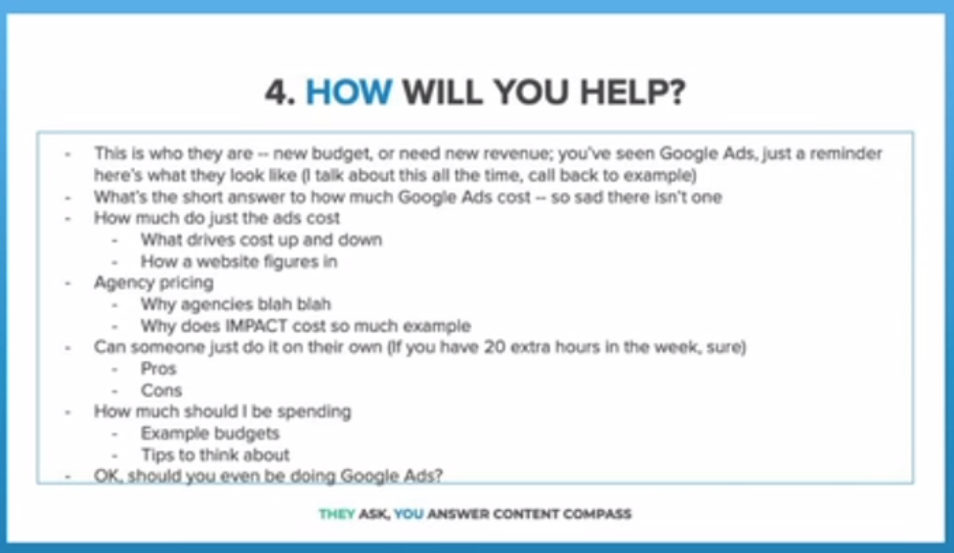
When we write all of these things down, we are able to create a strong vision in our minds for our article, which will inevitably help us write a piece that captures attention, engages, and converts.
Step 2. Creating a Compelling Introduction

If you want to write a strong masterpiece, the first step is to capture attention and engage, and what better way to do this than write a compelling introduction? Without a strong introduction, our prospect won’t even read the body of our article, and we will never generate revenue from our articles.
Every single introduction needs to answer the following questions in your customer’s mind:
- Is this piece of content for me?
- What problem or question are you going to help me solve?
- Why are you the #1 teacher in helping me solve my question or problem?
You can answer these three questions by using the PEP checklist.
- Problem: identify the problem your buyer has. You should talk from their perspective and call their feelings out, and then empathise with them. A part of this is showing them that you understand concern or pain point which they have.
- Expertise: identify why you’re the expert.
- Promise: outline what they’re going to walk away with from your content.
PEP isn’t a formula, but more of a checklist. You need to ensure you check these three things off in every introduction for it to be successful, but how you do it is where you can get creative.
There are six interesting ways you can utilise PEP.
Formula #1: Open with a compelling statistic
Statistics, when leveraged correctly, can create a sense of urgency and context. There are three essential elements to a successful compelling statistic.
- Always cite your stat data.
- The statistic should be followed by one or two statements to connect the stat to the main point.
- Don’t waste time – get to the point.
This strategy ONLY works if the statistic creates urgency by nature. It WILL not work if you have to spend time explaining why the statistic is important.
Here’s an example of this in use:
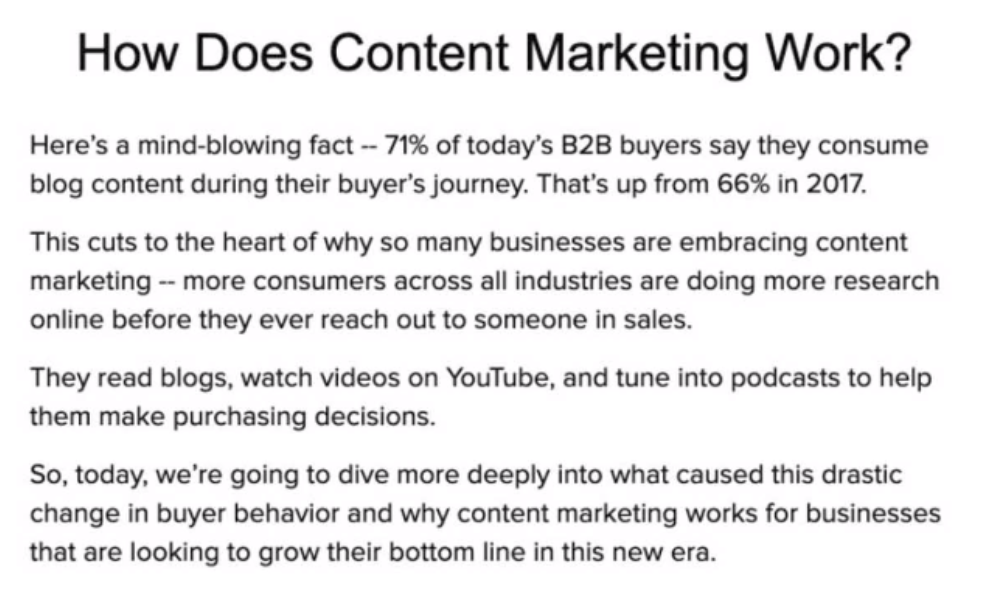
Formula #2: Ask a thought-provoking question
This allows you to immediately hook your audience with whatever your article is about. There are three elements which need to be present for this to be successful.
- The question or series of questions.
- An answer, rhetorical or otherwise.
- A lead into the meat and potatoes of your article.
These fail miserably when you rely on questions that are obvious or lazy throwaways, or ones that require too much explanation.
Keep the questions short, to the point, follow up with an answer and lead straight into the meat of the article. DO NOT make your reader think.
An example of this can be seen below:
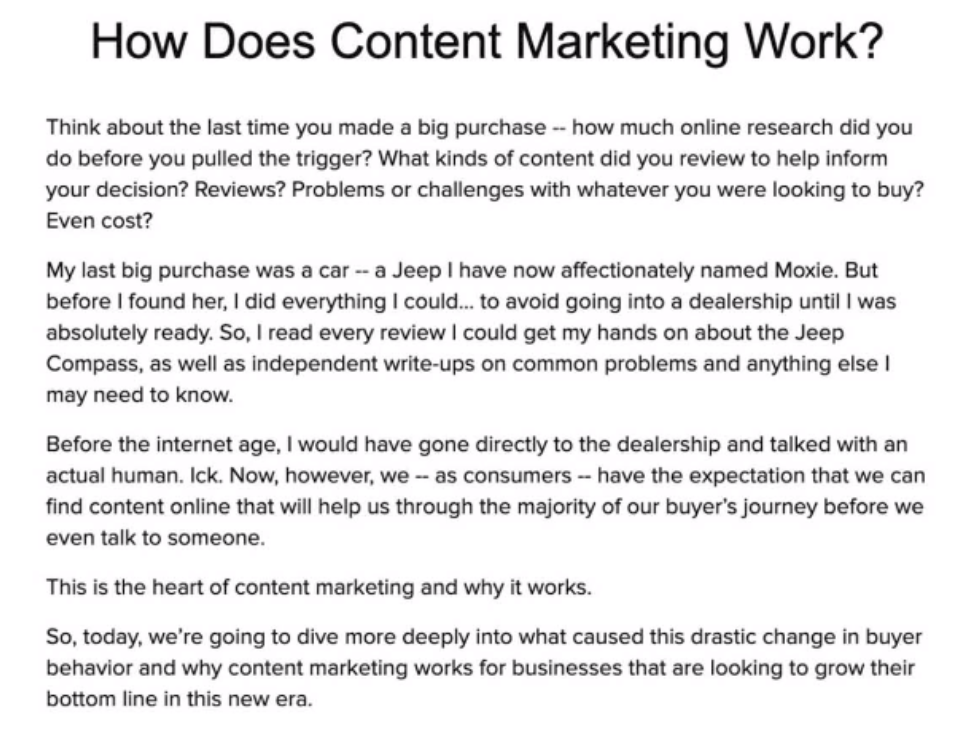
Formula #3: “Stop me if you’ve heard this one before”
You want to use hypothetical storytelling to connect to your audience’s pains and fears. This should be used when a compelling stat or question won’t help you connect to their pains but when you want to do so.
This opening allows you to, in great detail, demonstrate:
- Who you’re talking to
- Their problem and how they’re feeling
- What your solution is to their problem
Some audiences (those who lack patience) will hate this article, and those who want to get straight to the point will also hate it. Instead, use this weapon when you want to turn the volume up on an emotional piece.
An example of this can be seen below:
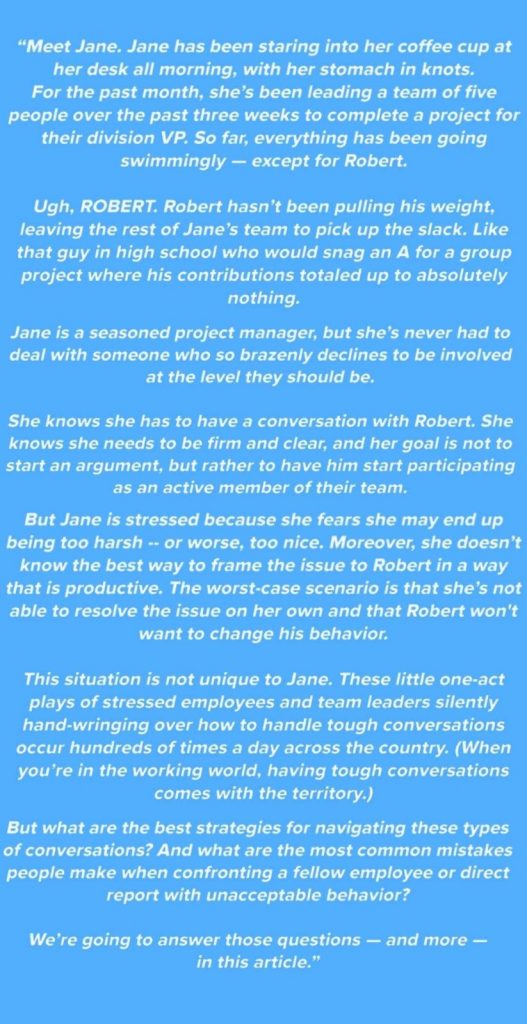
Formula #4: Read their minds, tell their story
This is where you show the audience that you understand their feelings and thoughts – that you know exactly where they are coming from. When they read this introduction, it should have the effect of making them think ‘Wow, they guessed exactly what I was thinking’.
There are two reasons this introduction style works:
- You’re showing them that you understand what they’re going through.
- You’re connecting to them on a human level, showing them that you are on the same level as them.
Creating trust happens in that micro moment when your audience feels seen and understood by you, and this introduction can help. This ONLY works well when someone is harbouring a private fear or anxiety and you call it out.
An example of this can be seen below.
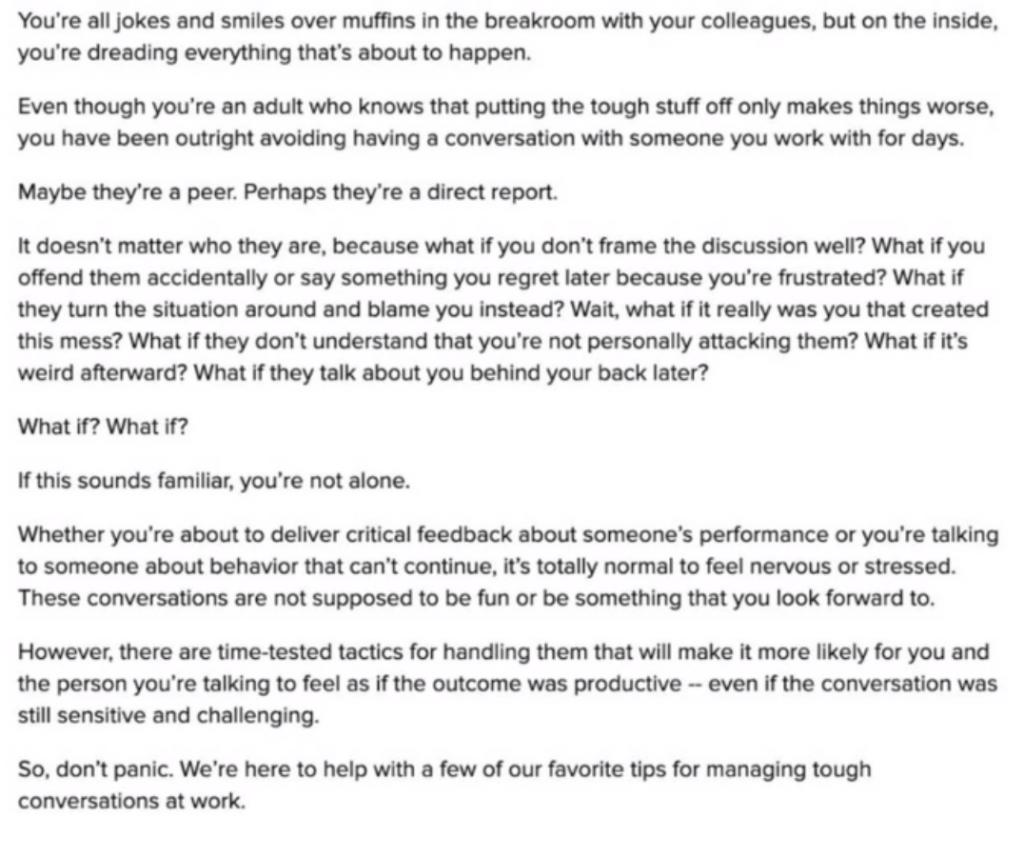
Formula #5: Share a relevant personal story
“I can help you because I’ve been you. You can trust me because I’ve been there”.
You build trust by sharing a personal story that shows the audience that you’ve been there and that you understand them.
You should follow these steps when writing this introduction style:
- Tell your story: use enough detail to bring them in and make them feel it, but not so much that you turn them off. Sometimes, you don’t even need to finish the story. You’re simply illustrating a moment in great detail.
- Turn to your audience with the narrative: stop talking about yourself and start talking to them. This helps contextualise what you’re talking about with them.
This is ideal for audiences who feel alone or are trying to answer a question that they feel is complicated or difficult to answer.
This introduction formula should ONLY be used if it makes sense based on the WHO section of your blog framework. Don’t simply use it for the sake of using it.
An example of this introduction style can be seen below.

Formula #6: Stir the pot with a controversial opinion
This is where you open the article with a BIG and BOLD opinion. If you disagree with something, lean into that way of thinking and use it as a launchpad to write your article.
Here are some DO NOTs for this introduction style:
- DO NOT tap dance around your opinions. You want to demonstrate your conviction and authority.
- DO NOT personally attack anyone – make sure you demonstrate that you disagree with the opinion of the person or party ONLY. You’ll most usually disagree with a majority as opposed to one individual.
- DO NOT go into battle without data / proof to back up your stance.
If you’re at a party and you agree with everything, you might be likable in that moment, but no one will remember you.
Below is an example of this introduction style.
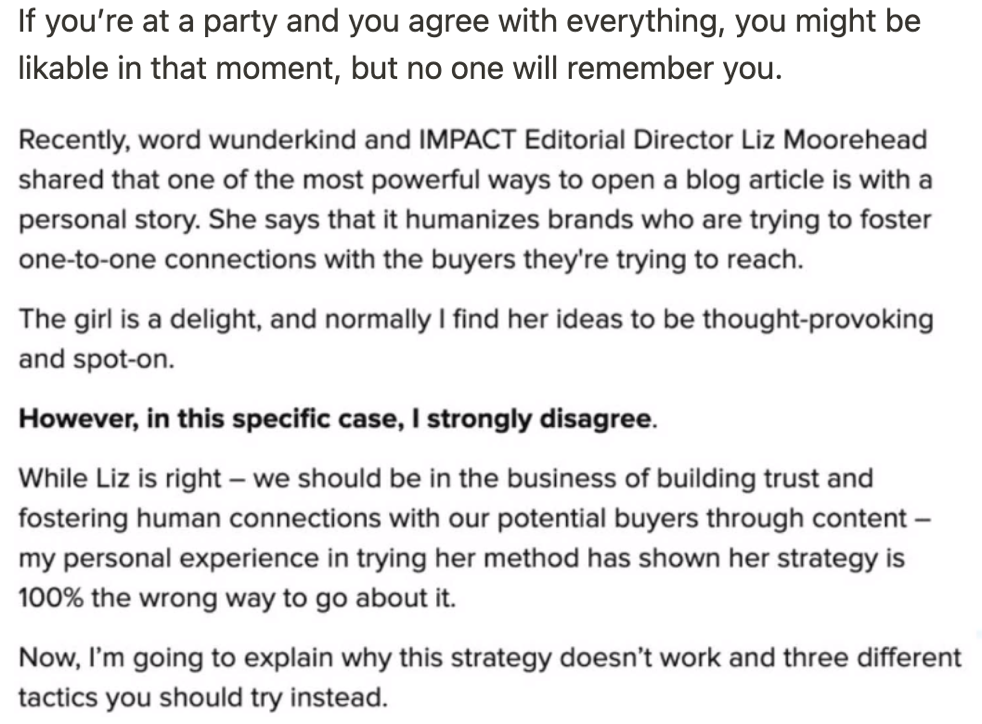
To recap, if you want to write a compelling introduction, first use the PEP checklist, and then use one of the introduction styles we covered to convey your thoughts.
Step 3. Writing an Unforgettable Body
The body of your article is the real meat of your piece, where your prospect will seek and discover answers to their biggest questions and concerns. As such, this section of your article should add EXTREME value to your audience.
Blog articles come in all shapes and sizes. The way they’re written, the way they look, the way they feel when they’re read…the different combinations are infinite.
So then, if there’s so many different ways to write a body, and if no one way is right or wrong, what formula can you follow to write an unforgettable body?
The secret is to BE that number one teacher in your space through the body of your article. Provide so much value, expertise, and information that your reader has no choice but to see you as the number one teacher in the space. When you can do this, your body becomes unforgettable, no matter what style you use to write it.
One secret tip to achieving this is to NEVER put a word limit on your articles. Write as much as you need to in order to completely answer and address your customer’s concerns and questions.
Other things you should keep in mind in order to write an unforgettable body include:
- Do not be a politician in your content – don’t answer their question by answering a different question or providing half answers. No sneaky BS – answer the question directly and honestly.
- Tell them WHY → tell them why each step matters, not just the how and/or what. You need to provide context!
- Provide lots of examples.
- It’s all about your mindset. “When I wrote this, did I genuinely try to be as accurate and thoughtful as possible?” If you did, then you win.
- Proofread your work – use software to do this. Mistakes will sometimes slip through cracks, but too many won’t be good.
Step 4. Writing a Show-Stopping Conclusion

The importance of a conclusion is that it is what turns your article into something that captures attention and engages, to something that inspires action and ultimately conversions.
So, how do we write a show stopping conclusion that rolls in the leads?
We must include the following ideas in our conclusion:
- So what? Show your reader why they should care about what you have written. You can do this by explaining how it is relevant to them.
- Why Now? Show your reader why it is important to take action now. We can do this by showing them the cost of inaction.
- What’s Next? Show your audience where the very next step is for them. What is the first thing they can do to get started? This can be especially useful in bringing it all together and setting an actionable step for the customer on blog articles that have many action steps or that might be about complex topics.
Following these steps isn’t a hard rule, but it guarantees that your conclusions will have the power to convert.
So, what’s next?
Writing blog articles is something that clearly impacts the bottom line. We know we should be doing it. But what we aren’t told is how to do it.
Making a content plan, writing a compelling introduction, writing an unforgettable body, and crafting a show stopping conclusion – these are the powerful ingredients to building a blog article that everyone will remember.
What’s the very next step you can take to bring your blog article writing to the next level?
Firstly, focus on getting just ONE thing right. Take something that stands out to you – perhaps it is one of the introduction styles, or perhaps it is the content plan. Take just one thing and focus on just doing that one thing. Once you can do that, pick another thing from this article that stood out, and add that to your toolbox. If you continue following this process, you’ll be able to write a killer blog article in no time!
Once you have the formula nutted down for writing a killer blog article, you’ll want to ensure you can generate revenue from your content writing. At RedPandas, we help train teams to implement a content system called They Ask You Answer which dramatically increases ROI, to the point where you can actually measure revenue generated from specific pieces of content.













